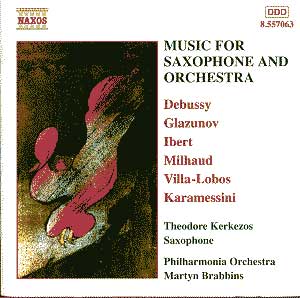Toulouse-Lautrec’s Loie Fuller graces the cover
of this CD evoking a fin-de-siècle atmosphere most appropriate
for Debussy’s 1908 Rapsodie. Elsewhere we range from Milhaud’s
commedia dell’arte and Ibert’s bustling syncopation through Villa-Lobos’s
nocturnal reflection and Glazunov’s ripe romanticism to Karamessini’s
spanking new ceremonial drama. The saxophone, alto and soprano, takes
on many guises here; prankster and trickster, romantic and saturnine,
crepuscular, balletic, acrobatic, avuncular or Dionysian – there’s plenty
of ground to cover.
Debussy’s Rapsodie was written in 1908 but the
scoring was only undertaken after his death by Roger-Ducasse in 1919.
Its nocturne grows sultry, the saxophone embedded in the score, taking
a primus inter pares role for some of the time – note Debussy’s
explicit title - and flecking it with distinctive cries. Milhaud’s Scaramouche
is better known in its two piano version. Vivacious and vital, its rhythmic
élan is unstoppable; its samba finale with chugging rhythm two
and a half minutes of, as Milhaud writes in the movement heading, Brazileira.
Ibert’s Concertino was written for one of the leading players
of the day, Sigurd Rascher, for whom Glazunov wrote his concerto and
Eric Coates his Saxo-Rhapsody amongst a number of other composers
(Rascher’s superb performance of the Coates is on a Pearl CD). Written
in 1935 and contemporary with the Coates and Milhaud works it is vaguely
Ravelian with a busy, forward moving solo line. There’s a considerable
amount of syncopation and drive and I would agree that the Concertino
was influenced by the – considerable – amount of good Jazz to be found
in Paris in the 1920s and 30s – rather than being in any way explicitly
a jazz work. The Larghetto is pleasant – in the main slow movements
here are elegant without being deep – but the finale much sprightlier.
Its brisk, neo-classical motor threatens fugal overload but bustles
defiantly on to the end.
Villa-Lobos’ Fantasia was written for either
soprano or tenor saxophone though most players take the former option.
It was dedicated to the dean of French saxophonists Marcel Mule (an
album currently devoted to Mule is available entitled ‘Le Patron of
the Saxophone’ – Clarinet Classics CC0013 - and includes the Ibert Concertino
dedicated to Mule’s rival Rascher. Mule disapproved of the high notes
Ibert interpolated at Rascher’s request). Rhythmically diverse with
slight ritardandos to relax into brief moments of romantic expression
the brisk opening movement gives way to a nocturnal second movement
introduced by solo viola. The finale runs the gamut of fleet fingered
virtuosity – from quick runs to high octane trills – in an explosive
passage of spirited enjoyment. After these joyful games the Glazunov
seems as if written in another age - which in a sense it was. It carries
with it the whiff of his Violin Concerto and is lush, romantic, delightfully
scored and unashamed to allow the strings their moment of effulgent
romanticism at 6.50 of this one-movement, nearly fifteen minute work,
the longest of the six. I first heard it on Felix Slovácek’s
Supraphon disc of 1980 and its charm never stales. The occasionally
discursive but animated cadenza is excellently negotiated by Theodore
Kerkezos and that noble fugal ending incisively done as well. Finally
to the Karamessini. Greek born she holds a doctorate in Composition
from the University of Sussex having earlier graduated from Berklee
and has composed widely. Her taut but incident-packed work runs for
fourteen minutes. Inspired by the Dionysian and Apollonian spirits the
saxophone becomes part of the fabric of the argument assuming a "transfigurative"
role. The work has rather a ceremonial, hieratic feel. There is some
splendidly surly orchestral writing in the opening movement notable
for its lines for solo violin and "overblown" saxophone. Colourful
and affirmatory the second movement leads on to a dramatic and sonorous
brass capped conclusion, full of processional vigour.
Excellent performances here from the Philharmonia under
Martyn Brabbins and a soloist of considerable presence – and an enticing
programme as well. This is a well-filled infectious delight.
Jonathan Woolf


